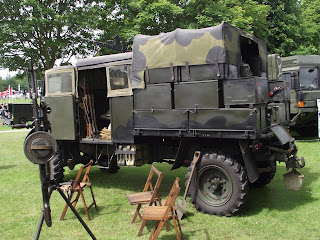This was a really good half day out and no mistake although officialdom served to make the ending somewhat, ahem, challenging....more of which later however.
Broadside is the wargames show organised by the Milton Hundreds Wargames Club in Kent and was held in the Swallows Centre, Sittingbourne. I would post a link to their website but it has been hacked and closed down as a result so the best I can do is to post the details listed on the following site -
Brigade Models MHWC.
For me the best thing about days like this is catching up with old friends and in that respect the blogging fraternity was very well represented. I chatted with Fran, Lee, Postie and Ray of the famous Posties Rejects - I caught up with Clint and his legendary chocolate truffles, Tamsin P the mythical beast (don't forget the Pyrates - it is spelt like that - as it is really funny) and figure painter par excellence and the redoubtable Mr Cordery. The spectrum of blogs covered looks something like this:
Wargaming Miscellany
The Angry Lurker
Wargaming Girl
Anything but a 1
Don't throw a 1
Big Lee's Miniature Adventures
My first order of business was with Dave Lanchester of
David Lanchester's Military Books to offload some spare titles from the collection and to take a long and envious look at some of the titles he has on offer. This was swiftly followed by a visit to Brigade Models to pick up a couple of packs of their really good 1/1200th scale Middle Eastern buildings. Brigade Tony is a sterling chap and he has been the source of all my ship flags for a number of years and with this new range of buildings (designed to be used with the Land Ironclads rules) he is really on to a winner in my opinion. I have a number of plans for these which will feature on the blog in due course.
Brigade Tony - before I had spent some money with him - he was smiling afterwards though....;-)
One half of Clint's very nice looking 1/2400th Napoleonic naval game....
....and the half half of the combatants who did not want to be left out....;-) To Clint though - many thanks for the Chocolate!
A beautiful looking Sudan game in 28mm....
....with a very impressive looking gunboat.
The Rejects were in action on the Boyne - once again I managed to miss out on a group shot of the gang in all its glory - sorry chaps! To Ray - once again many thanks for the 'secret project'.
Mr Fox and SEEMS took to the skies with this 1940 furball over France, being the first action of the day.
A 109 is trailing rather a lot of smoke but the Stuka seems to be unaffected and looking longingly at the target in front of it....
Courtesy of Bob Cordery - a pair of very welcome titles for the collection - especially the one on the right....We also discussed matters Chaco related and much food for thought has come out of this so thanks again Bob.
This was my 'Oooh Shiny' moment - but not in quite the way you would imagine.....
1930s tanks in action - what's not to love? This also has a cunning ulterior motive....
Bargains of the day though - all four of the above titles for the meagre sum of £5 each!
It was great to catch up with a lot of old friends (and new) and my only regret was that I did not allow myself enough time to take part in one of the club aerial dogfights. My parking ticket for the car had run out and I was loathe to part with even more money so basically I ran out of time. There was a warden lurking as well and so I decided that discretion was the better part of valour and headed for home. Still, it was a great day out all the same and I am quite sure that I will be able to revisit the scenarios Mr Fox had devised at a later date.
On the basis of today Broadside is very much a booked date in my calender and I shall look forward to next year with relish.






































